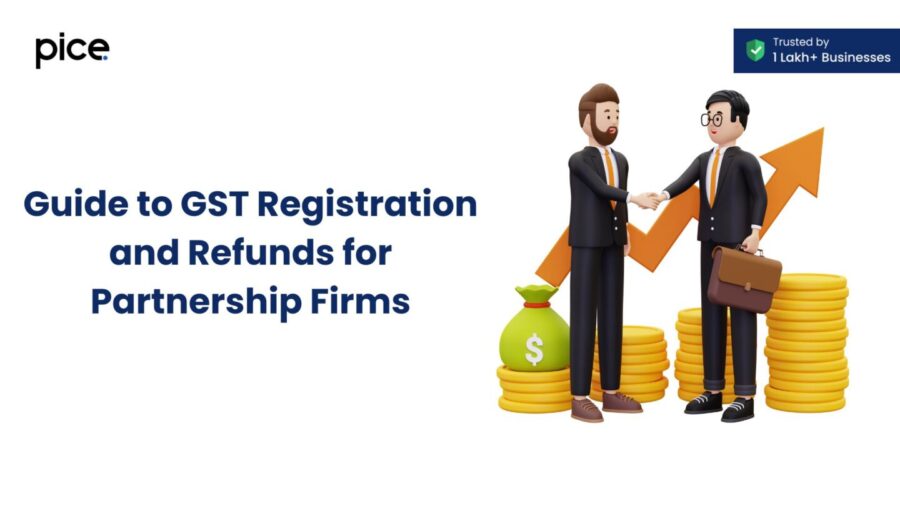Guide to GST Registration and Refunds for Partnership Firms
- 28 Aug 24
- 12 mins

Guide to GST Registration and Refunds for Partnership Firms
Key Takeaways
- Registering a partnership firm under GST requires documents like the partnership deed, PAN cards, address proof, and partner identity proofs.
- A Chartered Accountant's certificate is needed for submitting Form RFD-01 during the GST refund claim process.
- Declarations for a GST refund include proof that the supplier has not availed ITC and endorsements from SEZ authorities.
- The GST refund process involves submitting Form RFD-01, receiving Form RFD-02, correcting errors with Form RFD-03, and tracking the status online.
- Eligible items for a GST refund include exports, supplies to SEZs, excess payments, accumulated ITC, and refunds due to favorable legal decisions.
A partnership agreement brings together two or more individuals to collaborate on a business venture, sharing the profits earned. Any or all partners can manage the business. Partnership firms engaged in buying, selling or providing services must register under the Goods and Services Tax (GST) to claim input tax credit.
Registering a partnership firm under the GST Act gets simpler if you thoroughly know the documents required. In this blog, you will learn about the documents required for GST registration of partnership firms here followed by the steps to register your partnership firm with the State Registrar for complete compliance. Keep reading to know more.
Documents Required for Partnership Registration
Registering a partnership firm requires the documents of the firm as well as of the partners. Here is the list of documents that you need to submit while registering your firm under the Partnership Act, of 1932:
Partnership Agreement
A partnership agreement, also known as a partnership deed is a written document printed on a judicial stamp paper. It includes the rights and duties of the partners as well as the firm to avoid conflict of interest during operation. You can get your partnership deed from the State Registrar's Office duly signed by all the partners of the firm.
Firm Documents
The firm documents that you require for partnership registration are a PAN card of the firm and address proof.
- PAN Card: As a partner, you can apply for the partnership PAN card online using Form 49A and digital signatures by visiting the NSDL website. On the other hand, if you want to apply for a PAN card offline, you need to visit one of the PAN processing offices near you.
- Proof of Address: IIf the registered office space is rented, you need a rental/rent agreement as well as a utility bill. However, if the office space is a self-owned property, you need a utility bill in the owner's or partner's name.
Utility bills include electricity bills, property tax receipts, water bills and gas receipts. In addition, you will require an NOC or No-Objection Certificate from the landlord or the owner of the office space.
Partner Documents
The mandatory partner documents include a PAN card and proof of address. A PAN card acts as proof of the identity of the partner. Further, the address proof can be an Aadhaar card, Voter's Identity Card, Driving Licence or Passport, that the government authorises. Additionally, you can submit a utility bill as proof of address, provided it is not older than 2 months.
Additional Registration Documents
Partnership registration requires the partnership deed or agreement followed by the firm and partner documents. In addition, the partners need to submit an affidavit to the Registrar of Firms, declaring that all the details mentioned in the deed are true and correct.
GST Registration
All the documents of the partnership firm followed by the partner documents should be submitted for GST registration. The authorised signatory of the firm further has to sign the GST registration application with a digital signature or with E-aadhaar verification.
Active Bank Account
A partnership firm needs to open a current account with a bank for their transactions. Here are the documents that a firm requires to open an account:
- Partnership deed or agreement
- Partnership firm's PAN card and proof of address
- PAN card and address proof of partners
- Partnership registration certificate
- GST certificate of the partnership firm
- A copy of utility bills
- An authorisation letter on the letterhead of a firm to declare the authorised signatory for bank transactions.
Partnership Firm Registration Guide
The process of registering a firm starts with submitting a GST registration application, followed by selecting a name and obtaining a registration certificate. Here is a guide to firm registration:
- GST Registration Application
Step 1: Submit the application form to the State Registrar of Firms, mentioning the GST registration fees.
Step 2: All partners need to sign the application form before sending it to the Registrar’s office.
The application form should contain the name of the firm, permanent and other places of business, joining date of partners in the firm and proof of appointment, names and addresses of all the partners, and the tenure for which the firm exists.
- Name Selection of the Partnership Firm
While selecting the name of the firm,avoid identical names for existing firms. This helps create your firm's identity in the market. Further, avoid using names that depict a government department such as empire, emperor, crown and similar words.
- Certificate Registration
As a firm, you need to submit the registration fees along with the GST registration fees. The Registrar issues the registration certificate on satisfaction regarding all the documents and details provided by the partnership firm.
💡If you want to pay your GST with Credit Card, then download Pice Business Payment App. Pice is the one stop app for all paying all your business expenses.
GST Registration Turnover Threshold for Partnership Firms
The GST registration turnover threshold for firms under the composite scheme needs to be ₹1.5 crore. However, the annual turnover threshold for northeastern states needs to be ₹75 lakhs and for service providers, it needs to be ₹50 lakhs.
Taxpayers need to pay their tax payable on a quarterly basis while filing returns annually. The GST rate is fixed at 6% with a 3% central GST (CGST) and 3% state GST (SGST).
Document Required for GST Registration of Partnership Firm

A firm needs to submit certain documents for GST registration. Here are the common documents required for GST registration for a partnership firm:
- Partners' passport-size photos
- PAN card of the firm and the partners
- Aadhar card of the partners
- Proof of address of the place of business operation such as utility bills
- Partnership deed
- Authorisation letter and proof of appointment of partners
- Certificate of partnership registration as the proof of business registration and the application reference number
However, the required documents vary depending on the nature of the GST registration. Here is the table outlining the document requirement for GST registration:
| Type of GST Registration | Purpose of Registration | Documents to be Uploaded |
| Normal taxpayer registration (including composition dealer, government departments and ISD registrations) | For undertaking a taxable supply of goods/services | PAN card of the company (only in the case of a company) |
| PAN card and Aadhaar card of authorised signatory. The authorised signatory must be an Indian even in case of foreign companies/branch registration. | ||
| PAN card and address proof of all directors of the Company (partners in case of firm) | ||
| Address proof of principal place of business | ||
| Certificate of Incorporation given by Ministry of Corporate Affairs / Proof of constitution of business | ||
| Memorandum of Association / Articles of Association (only in case of company) | ||
| Board resolution appointing authorised signatory / Any other proof of appointment of authorised signatory (in JPEG format / PDF format, maximum size – 100 KB) | ||
| Bank account details | ||
| GST practitioner | For enrolling as a GST practitioner | Address proof of place where professional practice takes place |
| Photo of the applicant (in JPG format, maximum size – 100 KB) | ||
| Proof of qualifying degree (Degree certificate) | ||
| Pension certificate (only in case of retired Government officials) | ||
| TDS registration | For deducting tax at source | PAN and TAN number of the person being registered |
| Photo of drawing and disbursing officer (in JPG format, maximum size – 100 KB) | ||
| Photo of authorised signatory (in JPG format, maximum size – 100 KB) | ||
| Proof of appointment of authorised signatory | ||
| Address proof of tax deductor | ||
| TCS registration | For collecting tax at source (E-commerce operators) | PAN number of the person being registered |
| Address proof of tax collector | ||
| Photo of authorised signatory (in JPG format, maximum size – 100 KB) | ||
| Proof of appointment of authorised signatory | ||
| A non-resident OIDAR service provider | For online service providers not having any place of business in India | Proof of appointment of authorised signatory |
| Proof of non-resident online service provider (eg: Clearance certificate issued by the Government of India, Licence issued by original country or certificate of incorporation issued in India or any other foreign country) | ||
| Photo of authorised signatory (in JPG format, maximum size – 100 KB) | ||
| Bank account in India | ||
| Non-resident taxable person (NRTP) | For non-residents occasionally undertaking taxable supply of goods / or services in India | In the case of individuals, scanned copy of the passport of NRTP with VISA details. In the case of a business entity incorporated outside India, a unique number based on which the Country is identified by the Government of that country. |
| Address proof | ||
| Photo and Proof for the appointment of an Indian authorised signatory | ||
| Bank account in India | ||
| Casual taxable person | For non-registered domestic persons occasionally undertaking the taxable supply of goods / or services in India | Proof of constitution of business |
| Photo and Proof for the appointment of an Indian authorised signatory | ||
| Address proof | ||
| Bank account in India | ||
| UN bodies/embassy | For obtaining a Unique Identification Number to claim the refund of taxes paid on goods/services | Proof of appointment of authorised signatory |
| Photo of authorised signatory | ||
| Bank account in India | ||
| Bank Account Details: For bank account verification, you must upload a copy of a cancelled cheque or an extract of the passbook/bank statement (containing the first and last page). This should be in JPEG or PDF format, with a maximum size of 100 KB. | ||
| Address Proof: You must upload any one of the following documents: Property tax receipt Municipal khata copy Electricity bill copy | ||
| Additional Documents (Case-by-Case Basis): You must provide one of the following documents: Ownership Deed/Document Lease/Rental Agreement Consent Letter/NOC from the Owner | ||
GST Registration Process
Here is a step-by-step guide on how to register your partnership firm under the current GST regime:
Step 1: Visit the official portal of GST.
Step 2: Fill in the firm details followed by uploading the documents.
Step 3: Fill in the details pertaining to the partners and upload the necessary documents.
Step 4: Ensure you upload the authorisation letter.
Step 5: Enter the SAC/HSN details on the portal.
Step 6: Fill in the bank account details and bank statement.
Step 7: Ensure you submit the DSC/ EVC code to complete the GST registration process for your firm.
Advantages of GST Registration for Partnership Firms
There are multiple benefits that a firm can reap with GST registration. Some of these benefits are discussed below:
- The registration helps firms reduce the tax burden by enabling them to collect GST from end users or customers.
- Registering for GST helps firms claim input tax credits on the purchases. This helps the firms reduce their production cost while increasing profitability.
- It ensures GST compliance, thereby enabling the firms to avoid fines ranging from 10% to 100% of the due tax amount.
- It helps firms improve their reputation and credibility as they are entitled to issuing tax invoices.
Afterword
Now that you know the documents required for GST registration of partnership firms, you can seamlessly register your partnership firm and proceed with GST registration. This will help you reap the benefits of GST registration as a partnership firm such as enhanced credibility, reduced tax burden, claiming input tax credits and avoiding non-compliance fines.
FAQs
What are the documents required for GST registration for partnerships?
Is PAN mandatory for GST registration of a partnership firm?
What are the required documents for GST registration?
What is the GST registration fee for partnership firms?
What is the GST turnover limit for partnership firms?
What is the tax rate for partnership firms?
Can husband and wife be partners in a partnership firm?
 By
By 

















